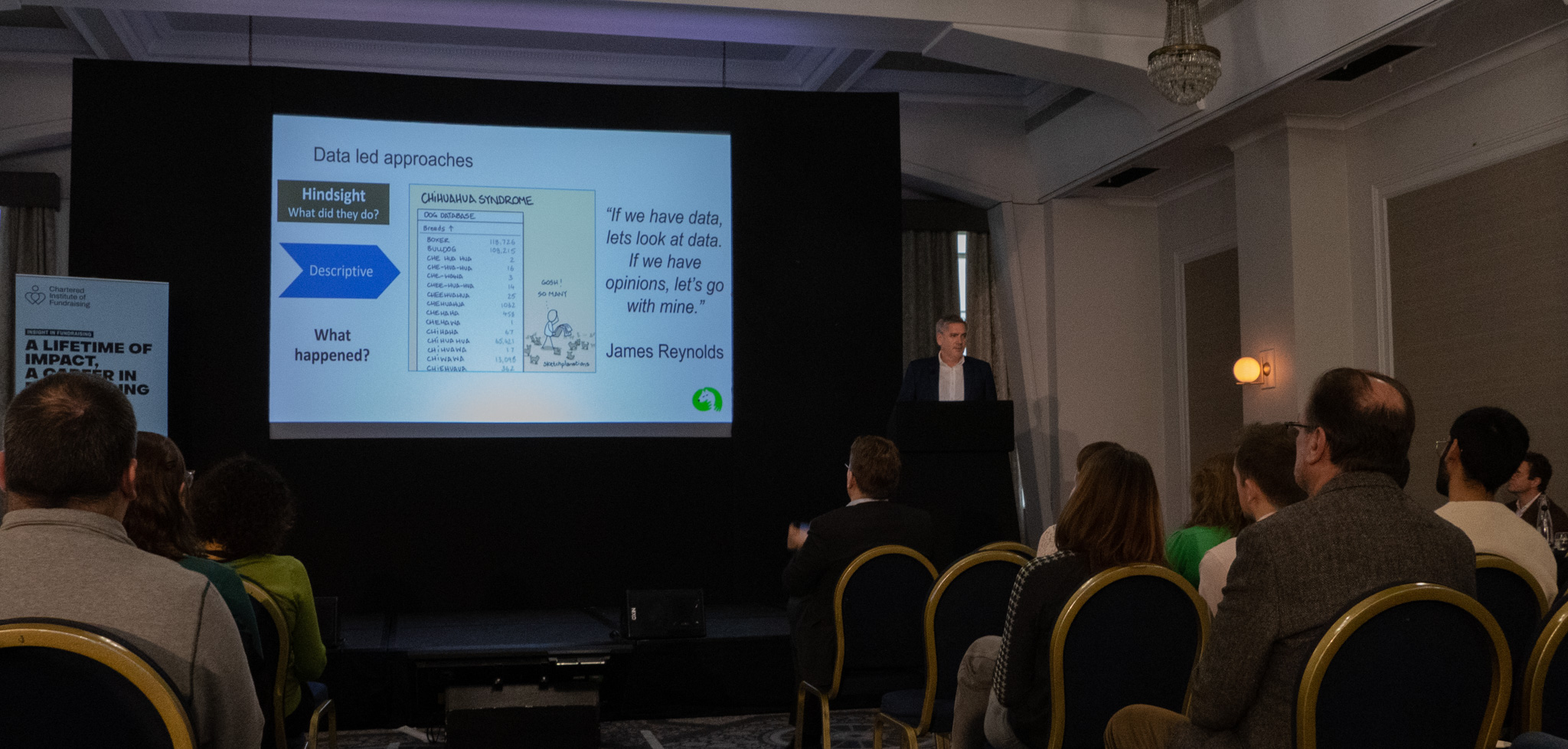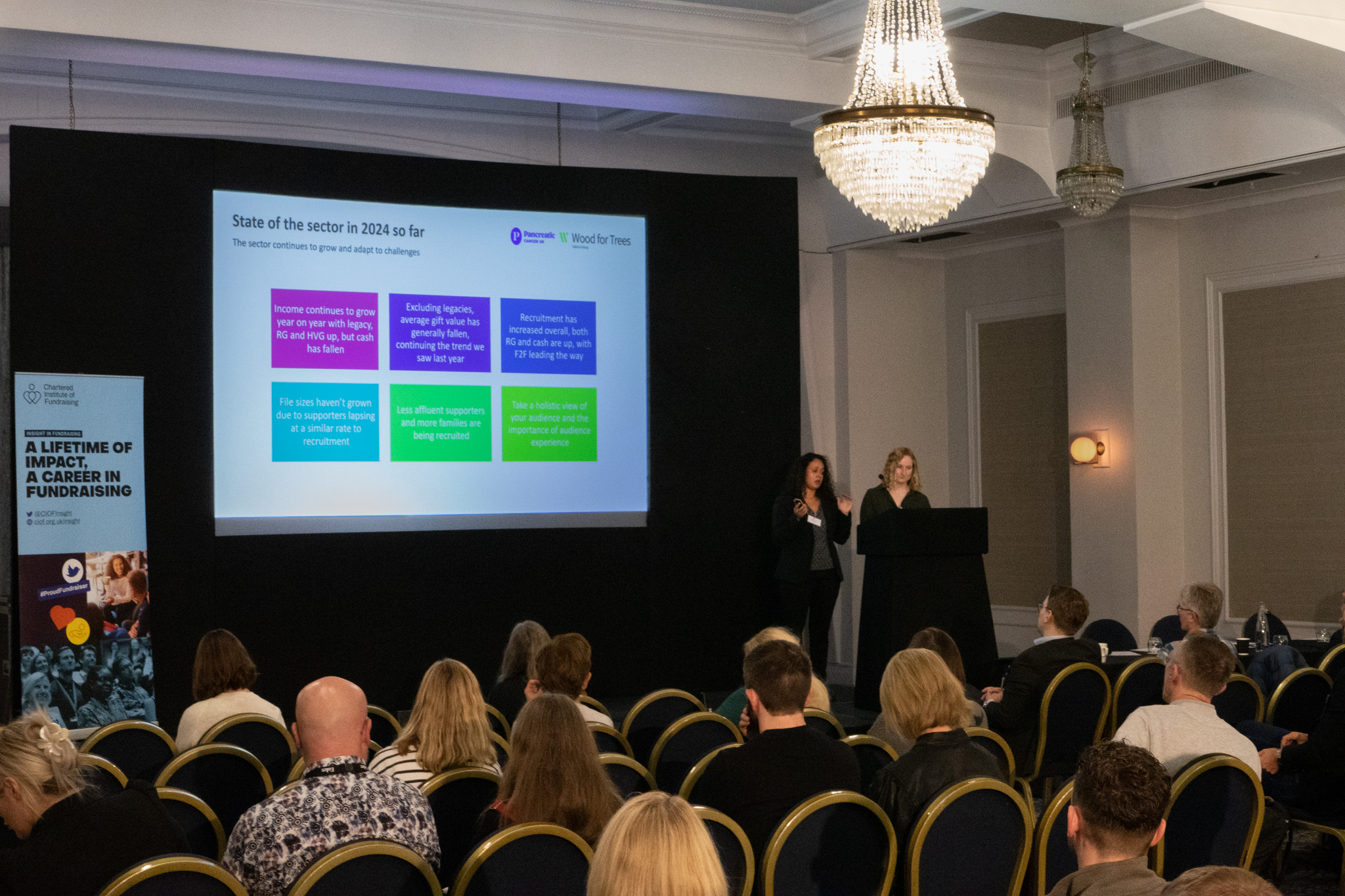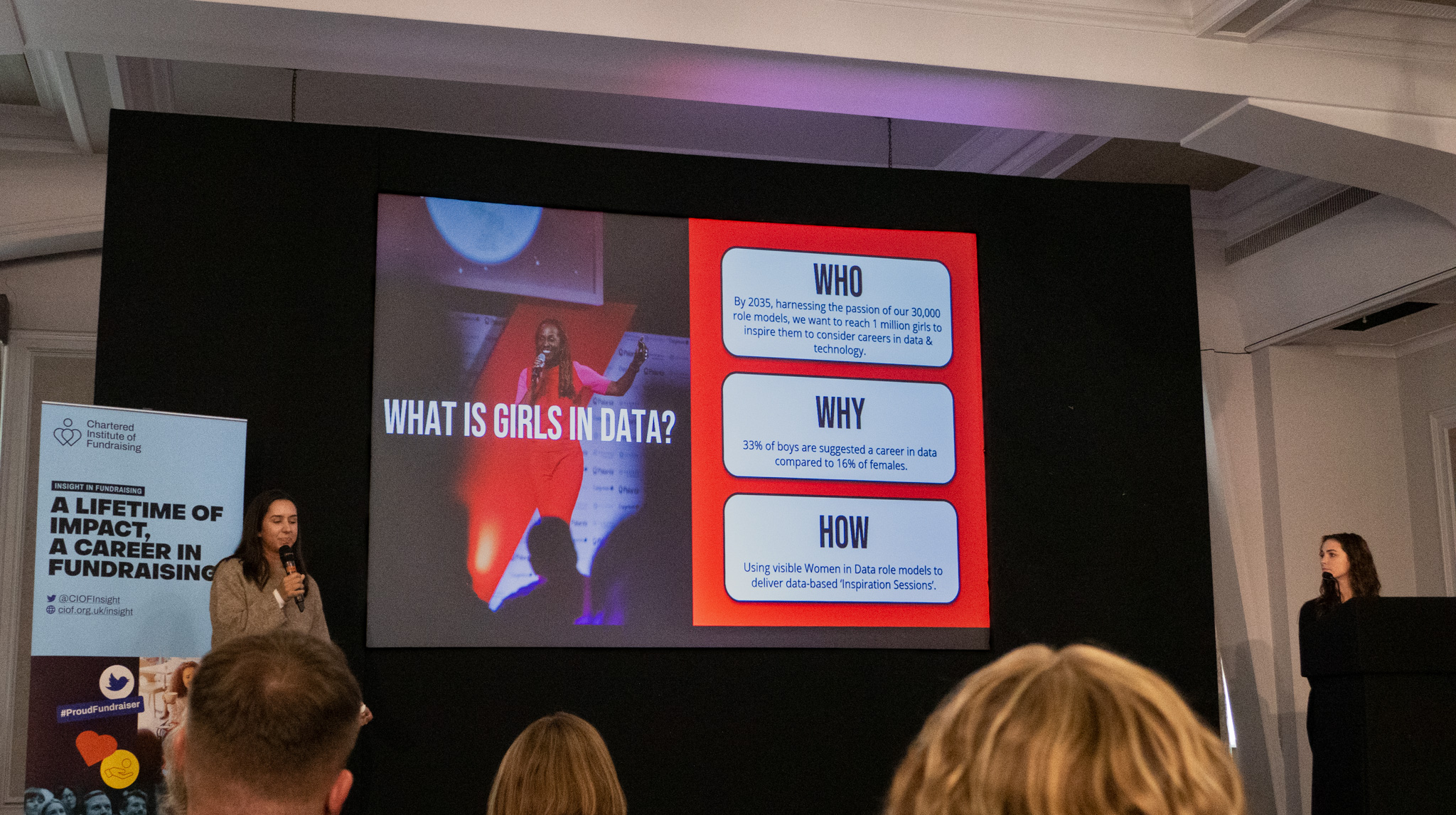By Rob Dyer and Kayleigh Philps
On Monday 14 October 2024, Rob and Kayleigh, plus other colleagues from Salocin Group, attended the CIOF Insight in Fundraising Conference, of which Wood for Trees was reception sponsor.

Between them, they tried to absorb as much of the content and attend as many of the talks as possible. So, without further ado, here are their combined reflections from the day!
Opening speeches
The morning started well with Steve White – CIOF Insight in Fundraising SIG Group Chair – opening the conference with rousing opening remarks. This year’s theme was data to decisions – creating impact through insight. A reminder – as if one was needed – that the key thing is that the work we do drives action. Insight needn’t always be revelatory. Sometimes, it cements what we thought to be true. But it should always be actionable…

Steve introduced Rohan Putter – CEO at Woodgreen Pets Charity – to give the morning’s plenary speech. One highlight for me during Rohan’s speech was his reference to Dan Pallotta’s Ted Talk: ‘What we think about charity is dead wrong’. I watched the video of this talk on YouTube a few years ago and have referred back to it many times since. If you haven’t seen it before, I can highly recommend it! Rohan also talked about the value of investing in insight and how a ‘return on investment in insight’ should be a KPI for organisations. Can charities really afford not to spend money on analysing the data they’re sitting on?

State of the charity sector
Next, I sat in on the ‘state of the charity sector’ talk our very own Jessie Parker delivered with Anna Frodsham from Pancreatic Cancer UK. Here, we learned how income has increased but average gifts have dropped in January-June 2024 compared with the same period in 2023. Interestingly, Anna said the charity has bucked this trend but gone to great lengths to reference things like the cost-of-living in their messaging to supporters. Pancreatic Cancer UK has also bucked a trend we’ve seen in terms of increased recruitment. This was largely because the charity has focused more on retention this year so far.

Other points of interest were around the size of opportunity presented by trillions of pounds in wealth expected to be transferred over the next 25 years. Charities that steward and market gifts in wills to supporters the best stand to bring in incredible donations. Even a small portion of the likely transferred wealth could be enormously valuable. The talk also noted some key changes in the mix of channels used by charities and the possible impact this has had on who’s been recruited and what this could mean in the near future given outside influences like the cost-of-living.
Find out more about the state of the charity sector in our January-June 2024 report.
Maximising your existing data
Elsewhere, Damon Boughen – Head of Development at Northampton Hope Centre – was presenting ‘maximising your existing data: quick wins for small teams’. This talk emphasised the importance of getting the most out of the data you already have and supplementing it with free data from elsewhere. Quick wins included segmenting your database using observable behaviours, such as starting or ceasing donations to key products and using this to tailor communications. It also demonstrated the importance of looking forward as well as back and using data to predict and forecast future activity. It’s incredible what can be achieved with little resource if efforts are applied in the right way!
Damon also noted the importance of incrementally cleansing data for best results and not to be overawed by sophisticated tools – you can achieve lots with familiar resources like Excel. Also, you can always use Google or other resources to learn how to do things or get reminders. Insider analyst secret alert; we all do it and possibly more often than you’d think. We’re not machines!
Finally, Damon highlighted the importance of focusing insight on a few KPIs and ensuring they really are the key ones. There were lots of questions on handling messy data too. This is a common problem – should you need any advice on this you can contact us to discuss things like hygiene reporting or otherwise download one of our whitepapers for some pointers.
Driving campaign success
Jodie Hanrahan, Senior Media Account Director at Join the Dots, delivered a talk entitled ‘driving campaign success with data-driven insights’. Jodie was joined by James Dalloway – Senior Data and Selections Analyst and Symon Russell – Executive Director of Individual Giving both from Air Ambulance Charity Kent Surrey Sussex. In this session we learned how TGI data helped understand various things about people, such as their media consumption habits, and how this could be used to attract new supporters as well as retain existing ones.

The session also covered leveraging media spends across other air ambulance charities to see what other media was in the market at the same time and cut through the noise. Jodie also talked about the power of JICMAIL and how this can supercharge direct mail. It was particularly interesting to see the ‘totaliser’ chart to record income and eye-tracking software to examine which parts of mail readers find particularly engaging.
Visit the KSS website to learn more about the their recent ‘buy it for life’ campaign, from what much of this talk drew upon (KSS and Join the Dots, alongside Open Creates, are shortlisted for Drum and DMA Awards 2024 for this particular campaign!).
Leveraging data for strategic fundraising
I sat in on ‘leveraging data for strategic fundraising: the RNLI lifetime value dashboard’ presented by Lloyd Sloan of Euler with Lee Gisbourne from the RNLI. Lloyd’s introduction really spoke to me and reinforced sensible things like lifetime value (LTV) being an indication rather than exact science, due to difficulties and ambiguity around calculating and recording cost.
Lee discussed how different measurements for metrics depending on the product causes problems and so aligning on how to calculate things is so important. Lee also talked about how cross-sell can be viewed as a measure of success in LTV calculations. It makes me want to know how equally supporters from different cohorts are asked to do different things and what this can tell us about LTV.
The session also reiterated how important it is to be flexible with cost data and use LTV calculations as a scenario planner – what if it cost us £x to recruit or retain supporters in future… how would that impact how we view their LTV?
Strategic growth journey
By this point, I was hankering for some caffeine! After a quick tea break and catching up with some familiar faces, I headed upstairs to listen to Gemma Cornwell’s talk. Gemma is a fundraising leader and strategist at Scleroderma and Raynaud’s UK (SRUK). Her talk was titled ‘transforming ambitions into reality – the strategic growth journey of SRUK’. I can’t take any credit for their work with Wood for Trees, having not been part of the team delivering it, but it was great to hear Gemma sing our praises and those she’d collaborated on a foundation audit with, which harnessed the data from SRUK’s CRM system.

Gemma spoke about how a systems review showed her and the SRUK team that there wasn’t a need to invest loads of cash in new technology. Instead, it was about making better use of existing resources. Also, a lack of expertise can be confused with a lack of technology. As ever, maximising what you have is a great thing to aim for. Gemma spoke passionately about stripping things back to basics and finding quick wins. Also, ensuring data is collected for a reason is important, as is using the collected data for a specific reason. This keeps things as lean and focused as possible. A data and digital strategy doesn’t stand on its own – it’s woven into everything a charity does. It also highlighted the cycle we go through regularly – great supporter journeys are designed and delivered using insight. And these journeys generate new insight, which can be used in future journeys. Gemma’s passion for what she does – and what we do – was palpable and I could have listened to her speak for hours!
Impact through insight
Next door, Craig Linton and Daniel To of Technology for Good were presenting with Helen West of Amnesty International. In their talk – ‘impact through insight: the good, the bad and the ugly of data’ – a list of data ‘sins’ were explored. These covered issues with data capture, inconsistent definitions and lack of documentation and poor data culture in an organisation. This really highlights the importance of getting the basics right and how investing in the basics stands you in good stead for all that comes after.
Are your supporters SAFE?
After that, I headed back downstairs to see Steven Dodds (from Beautiful Insights) and Julia Baxter of the University of Bristol deliver ‘are your supporters SAFE?’. The ‘SAFE’ part here refers to ‘satisfaction and future engagement’, where survey responses were used to assess the relationship between supporter and cause.

The talk showed some really interesting differences in motivations from supporters with high and low intent to give again in the near future. Understanding supporter motivation and getting to know the high intention group is key to maximising not only income but also supporter experience and it brought to mind interesting projects we’ve done previously on motivations and reasons for giving.
Another interesting point was the level at which printed communications were appreciated by supporters and so it seems striking a balance between the low cost and high efficiency of digital communications versus the higher cost and potentially better supporter experience of direct mail is a key one for us all to weigh up.
Why your charity might be doing better than you think
Upstairs, Poppy Okoboh of the The Air Ambulance Service discussed ‘retention: why your charity might be doing better than you think’. Here, an emphasis was placed on the relationship between organisation and supporter, and how maintaining affinity to the cause is crucial. A range of ways to measure retention were presented, going beyond second-gift rate. Among them was publication of a newsletter, which carries no explicit ask but does offer the chance to give feedback on a form and has been well engaged with so far. It was also nice to hear that churn analysis and contacting regular givers before they’re expected to lapse is part of their strategy – surely a great case for investing in predictive analytics.
Girls in data
It can be tricky to grab people’s attention after lunch – and a fabulous lunch it was too, ever the barometer of a good day out of the office at an event. However, the afternoon plenary session by Jenny Wilkins and Tori Tompkins of Girls in Data was likely the most inspiring talk of the day.

Inspiring younger generations is still the aim, but I think everyone in the room was captivated by their clarity and common sense to the issue of underrepresentation of women in data/insight jobs. They highlighted the importance of engaging with children at an early age in order to break down gender bias, which starts as early as age three. There were crucial differences in the ‘ideal jobs’ of boys and girls at school, with computer science being the third most popular choice for boys and no other data jobs in the top 10 for either gender.
The impact – potentially either positive or negative – of teachers and parents was discussed too, and other key points in development were highlighted, including age 10-14 where there’s maximum opportunity to change learned beliefs and stereotypes. Hats off to Jenny and Tori – not only for engaging with the congregation so well but for also delivering an important message that all of us can get behind. I know within our own organisation we’re already looking at ways in which we can help out!
AI and machine learning in the charity sector
A tough act to follow then, but next up I sat in on Alex Holt and Marc Dallimore’s talk on ‘AI and machine learning in the charity sector: what you need to know and how to get started’. Alex got things going by using the lifeblood of many analysts in an opening analogy – production (and consumption) of tea. A surefire way to hook this particular audience and get them warmed up to what you’re about to say. I found the discussion of AI ‘hallucinations’ particularly interesting and also that AI prompts consume around 100 times as much energy as a Google search (it was enough to convince me not to use ChatGPT to write this).

Marc’s ML analogy on sorting different sized buttons also landed well with me and I’ll try to do his delivery justice next time I attempt it. Marc picked up and discussed many of the practical examples and opportunities open to charities in beginning to use AI in their work, and – as importantly – where it’s not a good fit. Co-worker bias aside, they both brought clarity and common sense to an area that can be hazy and vague, and so credit to them for it. I certainly found new ways of understanding and explaining difficult concepts from it.
To find out more, and get started using AI safely, download our AI guide and complete our AI readiness framework questionnaire here.
How to start mapping
After that, and a short break later, I headed back upstairs to Erin Freeman’s talk on ‘how to start mapping’. Erin is a Supporter Insight Data Analyst at the Alzheimer’s Society and it was a pleasure to award her the rising star award later on in the evening! In agency land, there’s a saying that roughly goes “everyone loves a map” in a presentation and Erin’s presentation embodied that, going beyond the standard use to include various data to spot gaps, concentrations of target supporters and so on.
She gave a detailed account of how to get going using maps to illustrate a number of useful things in your analysis and she also gave practical advice on how best to set up for success. Having begun my own career in charity data (an incalculable number of moons ago) working on sector maps for door-to-door fundraisers, it was great to see the next generation of analysts speaking with passion on their subject. I also picked up a couple of tips on where to find good open-source data to use in analysis, which I am hoping to make use of soon!
Unlocking machine learning potential
After that, I hung around to listen in on Jez Clarke from Eden Smith talk about ‘unlocking machine learning potential for charities and future data scientists’. He was joined by Marie May – also of Eden Smith – and Mark Lumby of Marie Curie, who had first-hand experience of working with MSc student’s through Eden Smith’s nurture programme. This programme matches students with 12-week project placements to give them real world experience, as well as providing charities with short-term support to complement their resources or fill any skills gaps.
This talk also gave a reminder of the basics that projects can stand or fall upon clear problem statements and briefs, detailed scopes of work, proper onboarding of newcomers and so on.
The day was by this time drawing to a close, so I headed back downstairs for the closing remarks, given by Steve White of the Alzheimer’s Society. What really sets out the Insight in Fundraising SIG events for me is the collaborative spirit and how presentations aren’t just about showcasing success, but also to discuss failures and – most crucially – sharing how things are done, not just what happened. If only all events were as inspirational and high quality as this – an insightful day was definitely had by all!
